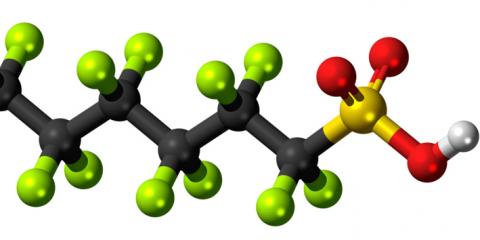Prenatal exposure to a mixture of endocrine disruptors is associated with poorer metabolic health in childhood
A study conducted in Spain and five other European countries shows that exposure to mixtures of endocrine disruptors during pregnancy is associated with metabolic health problems in children. The research, published in JAMA Network Open, followed more than 1,100 mother-child pairs between 2003 and 2016 and found a correlation between measures of metabolic dysfunction in children aged 6-11 years, and their prenatal exposure to chemicals such as metals or organochlorine pesticides, among others. According to the authors, these results could be related to the current increase in metabolic syndrome across the lifespan, which results in an increased risk of cardiovascular disease and type 2 diabetes.

Montse Marques - disruptores embarazo EN
Montserrat Marqués Bueno
Researcher at the Laboratory of Toxicology and Environmental Health, Department of Basic Medical Sciences, Universitat Rovira i Virgili.
This study led by the Barcelona Institute for Global Health (ISGlobal) and published in Jama Network Open stands out for its robustness, supported by a large sample of 1,134 mothers and children from six European countries, and a comprehensive analysis of prenatal exposure to 45 endocrine disruptors. The findings are based on detailed data from biological samples and clinical follow-up of children aged 6-11 years, which strengthens the validity of the results.
This study contributes to the field by exploring the combined impact of various endocrine disruptors on metabolic health, revealing that prenatal exposure to a mixture of these compounds is associated with an increased risk of metabolic syndrome in childhood, with prominent differences by compound and sex. In contrast to previous studies, this work has been able to consider dietary and lifestyle differences at the European level and expands the number of endocrine disruptors analysed, as well as addressing mixtures, reflecting more accurately the reality of exposure to multiple chemicals. However, as a limitation, the difficulty in establishing a definitive causal relationship is acknowledged due to the observational nature of the study and the influence of other environmental and genetic factors.
In practical terms, these findings underscore the importance of reducing exposure to endocrine disruptors during pregnancy and the need to provide standardised information for their mitigation. Currently, while pregnant women are often advised to avoid foods, such as unpasteurised cheese or raw foods, to minimise the risk of microbiological contamination, there is a general lack of awareness of exposure to endocrine disruptors, such as BPA in canned foods or parabens used as preservatives in personal care and hygiene products. However, the responsibility should not be placed solely on the population; it is essential that stricter public health policies and regulations are implemented to safeguard the metabolic health of future generations.
Ángel Nadal - disruptores embarazo EN
Ángel Nadal
Professor and vice-director of the Institute for Research, Development and Innovation in Health Biotechnology of Elche (IDiBE) of the Miguel Hernández University
As far as my experience goes, it is a high quality work with solid data and methods. It is published by internationally renowned scientists in a leading journal in medicine and public health.
This study confirms previous results from testing compounds at the individual level. It confirms that prenatal exposure to persistent endocrine disruptors, i.e. compounds that accumulate in fatty tissues, including metals such as mercury, organochlorine pesticides, polybrominated diphenyl ethers (PBDEs) used as flame retardants in plastics among other materials and perfluoroalkyl substances (PFAS), which are widely used in everyday objects, are associated with an obesogenic effect and poorer metabolic health in children aged 6-11 years.
The study looks at exposure of mothers by groups of endocrine disruptors rather than individually. It is closer to the actual exposure we suffer; we are not exposed to a single endocrine disruptor, but to a mixture of them. The sample of mothers used is large, more than 1,100, which has made it possible to analyse the association with parameters related to metabolic disturbances in offspring by sex. It is, in fact, one of the few studies to analyse sex differences and find that girls are more susceptible to exposure to PFASs and PCBs.
There are several limitations that the authors identify in the study. One that I think is important to highlight is the large variability in the measurement of non-persistent endocrine disruptors such as phthalates and phenols. This is important because these disruptors have been associated with an obesogenic and diabetogenic effect when studied individually and this study does not confirm this association. This is a result to be taken with great caution.
There is increasing evidence from both experimental animal studies and epidemiological studies of the obesogenic, diabetogenic and metabolic deleterious effect of exposure to endocrine disruptors. Similarly, at the clinical level, obesity and even type 2 diabetes occur in younger individuals. Poor metabolic health in childhood predisposes to metabolic syndrome in adulthood. Obesity is a public health problem that requires policy and regulatory change and should not be tackled by diet and drugs alone. The 2030 strategy needs to be enforced and exposure to endocrine disruptors needs to be limited at European level. For the time being, at the individual level we can try to reduce exposure as much as possible, especially in periods of increased susceptibility such as pregnancy and the first three years of life.
Marieta y Vicente - disruptores embarazo EN
Mariana F. Fernández Cabrera
Professor at the University of Granada and researcher at the Cybernetics Centre for Epidemiology and Public Health (CIBERESP) and the Institute for Biomedical Research of Granada (ibs.GRANADA)
Vicente Mustieles
Researcher at the University of Granada and the CIBER of Epidemiology and Public Health
The prevalence of abdominal obesity, elevated blood pressure, inadequate lipid levels and hyperglycaemia, all components of the metabolic syndrome (MetS), is increasingly prevalent in children. These early clinical manifestations in turn increase the risk of cardiovascular disease in adulthood. In order to implement effective preventive measures, it is necessary to understand the origin and development of obesity and metabolic syndrome and to identify the associated modifiable risk factors.
Güilt-Oumrait's work, published in JAMA Network Open, explores the origin of metabolic syndrome in childhood, investigating the role of early exposure (preconception, prenatal and early life) to four families of chemicals (metals and organohanohalogen compounds - chlorinated, brominated and perfluorinated) in this disease. The researchers found that high maternal exposure to these obesogenic pollutants was associated with a significantly increased risk of metabolic syndrome in children aged 6-11 years in the Human Early Life Exposome (HELIX) population cohort.
Toxicological data indicate that the selected chemical families can induce adverse multisystemic metabolic effects. For example, perfluorinated compounds (PFAS) accumulate in the liver, contributing to fatty liver and dyslipidaemia, and some organochlorine compounds, accumulated in adipose tissue, are associated with obesogenic and diabetogenic effects.
The authors also included in this work clinical metabolic markers measured in the children's serum and urine, which reinforced and explained the results found. Moreover, since the diagnosis of MS in children is not an easy task, the authors propose a ‘risk score’ to facilitate the identification of clinical MS in childhood before it appears. The variables finally included in the proposed score were waist circumference, systolic and diastolic blood pressure, triglyceride, HDL-cholesterol and insulin levels, which allowed them to identify the most at-risk population of children.
The work of Güilt-Oumrait et al. therefore:
- It represents a solid advance in the epidemiological and toxicological knowledge of the health consequences of early (in utero) exposure to mixtures of chemical-persistent substances that can alter the metabolic programming of the infant population.
- It allows the identification of particularly vulnerable populations.
- It allows the establishment of preventive measures in children at high cardiovascular risk.
Although observational studies do not allow to establish definitive causes, the consistency of in vitro, in vivo and epidemiological data strongly argues for the need to reduce exposure to chemical-obesogenic compounds and/or metabolic disruptors, especially in women of childbearing age and during the first years of life (children).
Nuria Güil-Oumrait et al.
- Research article
- Peer reviewed
- Observational study
- People



